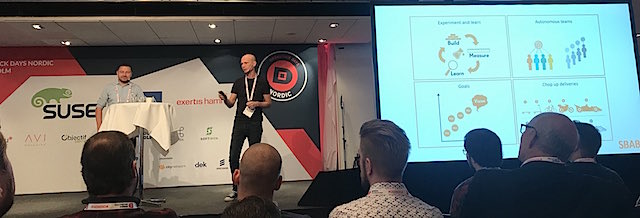STOCKHOLM – At OpenStack Day Nordics, Klas Ljungkvist and Patrice Mangelsdorf from Sweden’s SBAB gave the audience a roadmap for how they’ve doubled the features they deliver to customers year over year by moving to a micro-services architecture and OpenStack private cloud by City Network.
For a little background, state-owned SBAB has been around since the 80s focused on home mortgages, private savings and some business-to-business products. An early digital-first pioneer, they never built brick-and-mortar offices but operated strictly with phone services and limited online support as early as the 90s.
As the banking industry has digitized very rapidly, SBAB was well positioned to capitalize through online banking and mobile apps. In the most recent quarter available, lending rose to $US 38.9 billion (SEK 351.52) and the company continued its innovative path with “green mortgages,” or discounted interest rates for customers choosing houses with an high energy ratings.
With about 100 of its 500 employees focused on technology, including data science and delivering new services, SBAB needs to move quickly and deliver value for its customers to compete. Prior to 2017, SBAB followed a pattern of large, monolithic monthly releases that required the team to take systems offline over the weekend to push everything into production and then turn the lights back on for customers come Monday morning.

SBAB embarked down a micro-services path, organizing their technology department into about 12 teams that work autonomously to push features and achieve common goals. Each team of 10 counts about five or six engineers, a business analyst, a product owner and a specialist. They took a page from the agile playbook with an approach to build things small and get them out to the customers as soon as possible and then react quickly to feedback or failure.
But while it’s easy to say, it’s difficult to get people to change their mindset in practice. To help achieve the goals, each team owns their own component stack and 95 percent of the work doesn’t need to touch the other teams. That means if one team has a problem, the other teams can still keep running. There’s also a focus to automate and speed every process, starting with the OpenStack platform, as well as leveraging tools like Ansbile, Docker and Jenkins.
“If you think things are going ‘well enough’ and you’re not continually pushing to move faster and deliver more value, you’re going to fall in the digital market” –Klas Ljungkvist
So why did SBAB choose OpenStack and specifically City Network? The financial services industry is regulated in Sweden, so they needed compliant infrastructure, but they were suffering from vendors who were not delivering fast enough. They wanted more control, but primarily they wanted more speed. SBAB now has a team of four-to-five people who work with City Network to manage the OpenStack infrastructure, but after investing time to set the groundwork it “generally flows pretty well on it’s own. They’re not having to muddle in the infrastructure on a regular basis.”
Fast forward to September 2018, SBAB has pushed more than 300 features, doubling their productivity year over year and blowing out their key performance indicators. The team has now increased their goal to 400 features per month by December and is making good progress toward the new goal.
Klas closed the session by warning not to become complacent. If you think things are going ‘well enough’ and you’re not continually pushing to move faster and deliver more value, you’re going to fall in the digital market. It’s all about speed.
Come hear Ljungkvist talk in-depth about digital speed and flexibility at SBAB at the Berlin Summit keynotes.
- What’s the value of contributing to open source? - October 17, 2018
- How one of Sweden’s largest online lenders optimizes for speed - October 11, 2018
- How AI and IoT drive open infrastructure in Taiwan - August 27, 2018

)







